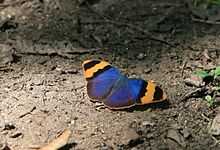Euphaedra neophron
From Wikipedia, the free encyclopedia
| Euphaedra neophron | |
|---|---|
 | |
| Scientific classification | |
| Kingdom: | Animalia |
| Phylum: | Arthropoda |
| Class: | Insecta |
| Order: | Lepidoptera |
| Family: | Nymphalidae |
| Genus: | Euphaedra |
| Species: | E. neophron |
| Binomial name | |
| Euphaedra neophron (Hopffer, 1855)[1] | |
| Synonyms | |
| |
The Gold Banded Forester (Euphaedra neophron) is a butterfly of the Nymphalidae family. It is found in eastern and southern Africa.
The wingspan is 55-65 mm for males and 60-78 mm for females. Adults are on wing year round, with a peak from February to July.[2]
The larvae feed on Deinbollia oblongifolia and Blighia unijugata.
Subspecies
- Euphaedra neophron neophron (northern Tanzania to northern KwaZulu-Natal, Malawi (Usambara Mountains), eastern Zimbabwe (Chirinda Forest, Sabi Valley))
- Euphaedra neophron ellenbecki Pagenstecher, 1902 (northern Kenya, southern Somalia)
- Euphaedra neophron kiellandi Hecq, 1985 (southern Tanzania)
- Euphaedra neophron littoralis Talbot, 1929 (south-eastern Kenya (coastal forests))
- Euphaedra neophron meruensis Carpenter, 1935 (Mount Kenya)
- Euphaedra neophron rydoni Howarth, 1969 (Pemba Island)
- Euphaedra neophron violacea (Butler, 1888) (Kenya (Taveta, Kasigau), northern Tanzania (Mount Meru, Mount Kilimanjaro))
References
| Wikispecies has information related to: Euphaedra neophron |
| Wikimedia Commons has media related to Euphaedra neophron. |
This article is issued from Wikipedia. The text is available under the Creative Commons Attribution/Share Alike; additional terms may apply for the media files.